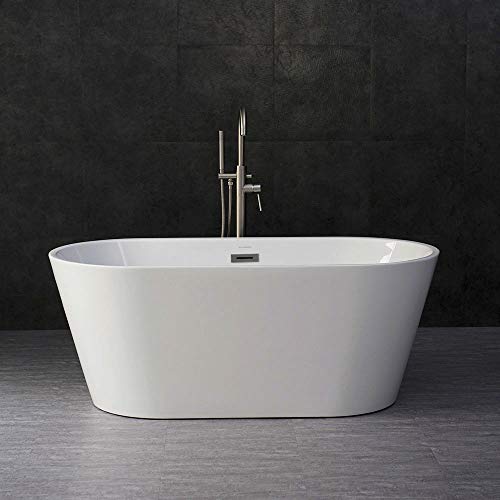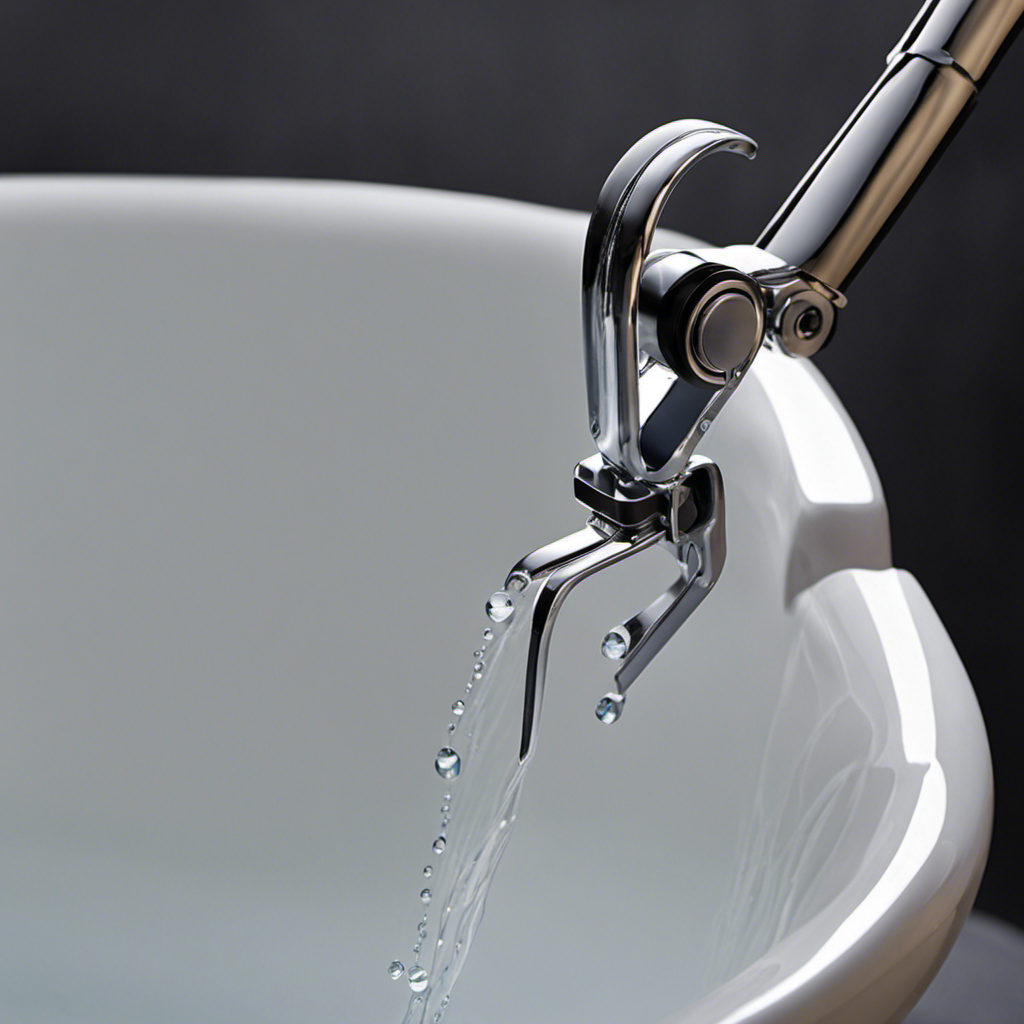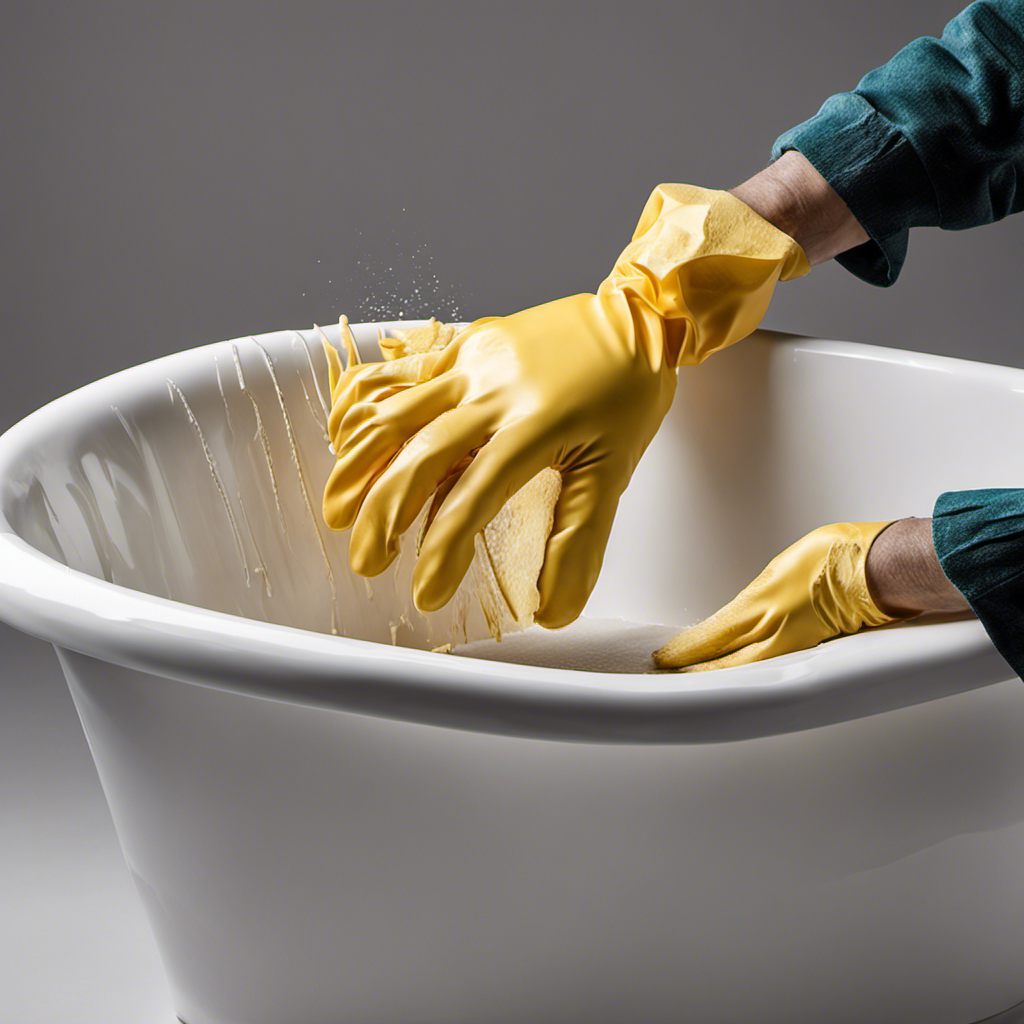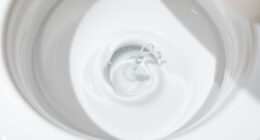If your bathtub is looking grimy and in desperate need of a thorough cleaning, you’re in the right place. In this article, we will guide you step by step on how to clean your dirty bathtub and restore its sparkling cleanliness.
From assessing the level of dirt and grime to addressing hard water deposits, we’ve got you covered. So grab your cleaning supplies and get ready to tackle that bathtub like a pro.
Key Takeaways
- Inspect the bathtub surface for stubborn stains, soap scum, and buildup, paying attention to corners, grout lines, and around the drain.
- Choose the appropriate cleaning solution and technique based on the type of stain and the material your bathtub is made of.
- Gather the necessary cleaning supplies, including an all-purpose cleaner, a sturdy scrub brush, and a microfiber cloth or sponge.
- Prevent future dirt buildup by establishing a regular cleaning routine, using shower curtains or mats, and wiping down surfaces regularly with mild cleaners or a mixture of water and vinegar.
Assess the Level of Dirt and Grime
You should start by taking a close look at how dirty and grimy your bathtub is. Assessing the level of dirt and grime will help you determine the cleaning needs and the best cleaning techniques to employ.
Grab a flashlight and inspect the surface of your bathtub, paying attention to areas like the corners, grout lines, and around the drain. Look for stubborn stains, soap scum, and any other buildup.
Take note of the type of material your bathtub is made of, whether it’s porcelain, acrylic, or fiberglass, as different materials may require different cleaning products and methods.
Gather the Necessary Cleaning Supplies
To start, make sure you have all the necessary cleaning supplies at hand. Here’s a list of the items you’ll need to effectively clean your dirty bathtub:
-
All-purpose cleaner: Look for a cleaner specifically designed for bathroom surfaces. This will help remove soap scum, grime, and other common bathtub stains.
-
Scrub brush: A sturdy scrub brush with stiff bristles will help you tackle tough stains and scrub away dirt and grime. Make sure the brush is suitable for the surface of your bathtub to avoid any scratches.
-
Microfiber cloth or sponge: These tools are great for wiping down and drying the bathtub after cleaning. They are absorbent and won’t leave behind lint or streaks.
Prepare the Bathtub for Cleaning
When it comes to removing stubborn stains from your bathtub, there are a few key points to keep in mind.
First, you’ll want to identify the type of stain you’re dealing with, whether it be rust, soap scum, or hard water deposits.
Once you know the type of stain, you can choose the appropriate cleaning solution and technique to effectively remove it.
Additionally, to prevent future dirt buildup, it’s important to establish a regular cleaning routine and take preventative measures such as using a shower curtain or mat to minimize contact between the bathtub surface and dirt or grime.
Removing Stubborn Stains
If your bathtub has stubborn stains, start by mixing baking soda and vinegar to create a powerful cleaning solution. Here’s how to remove tough stains from your bathtub using natural cleaning solutions:
- Sprinkle a generous amount of baking soda onto the stained areas of the bathtub.
- Pour vinegar onto the baking soda, creating a fizzing reaction.
- Use a scrub brush or sponge to scrub the stained areas, applying firm pressure.
The combination of baking soda and vinegar helps to break down and lift the tough stains from the surface of the bathtub. After scrubbing, rinse the bathtub thoroughly with water to remove any residue.
For particularly stubborn stains, you may need to repeat the process or let the solution sit for a few minutes before scrubbing. Remember to always test any cleaning solution on a small, inconspicuous area of the bathtub first.
Preventing Future Dirt Buildup
One way you can avoid future dirt buildup is by regularly wiping down the surfaces in your bathroom. By doing this, you can prevent mold growth and maintain a clean and hygienic environment.
Start by using a mild cleaner or a mixture of water and vinegar to wipe down your bathtub, sink, and countertops. Make sure to pay special attention to areas that are prone to moisture, such as corners and grout lines. Use a soft cloth or sponge to remove any dirt or grime.
Additionally, it is important to maintain a regular cleaning schedule. Set aside a specific time each week to clean your bathroom thoroughly, including scrubbing the bathtub. This will help prevent dirt buildup and ensure that your bathroom stays clean and fresh.
Clean the Tub Surface
Now that you’ve prepared the bathtub for cleaning, it’s time to focus on cleaning the tub surface.
In this discussion, we will cover three key points to help you achieve a sparkling clean tub.
First, we will explore effective methods to remove stubborn stains that may have accumulated over time.
Next, we will discuss how to choose the right cleaning products that will effectively tackle dirt and grime.
Lastly, we will provide tips on preventing future dirt buildup, ensuring that your tub stays clean for longer periods.
Remove Stubborn Stains
To remove stubborn stains from your dirty bathtub, start by applying a mixture of baking soda and vinegar. Here’s how to do it:
- Create a paste by mixing equal parts baking soda and vinegar in a bowl. The fizzing action will help loosen tough grime and soap scum.
- Using a sponge or cloth, apply the paste onto the stained areas of your bathtub. Make sure to cover the entire surface evenly.
- Let the mixture sit for about 15-20 minutes to allow it to penetrate the stains. This will help break down the grime and make it easier to remove.
After you’ve successfully removed the stubborn stains, it’s time to move on to the next step: choosing effective cleaning products. These will ensure that your bathtub stays clean and stain-free for longer periods of time.
Choose Effective Cleaning Products
After successfully removing stubborn stains, it’s important to choose effective cleaning products to keep your bathtub clean and stain-free for longer.
When it comes to choosing cleaning products for your bathtub, it’s worth considering eco-friendly alternatives. These products are not only better for the environment, but they are also safer for you and your family. Look for cleaning solutions that are labeled as ‘green’ or ‘eco-friendly’ and avoid products that contain harsh chemicals.
Another option is to compare homemade cleaners, which can be just as effective as store-bought products. For example, a mixture of baking soda and vinegar can work wonders on tough bathtub stains. Additionally, lemon juice and hydrogen peroxide are also natural cleaners that can be used to remove grime and keep your bathtub looking fresh.
Prevent Future Dirt Buildup
To prevent future dirt buildup in your tub, make sure to regularly wipe down the surfaces and dry them thoroughly after each use. This simple maintenance tip will help keep your bathtub clean and hygienic.
Here are three cleaning techniques and maintenance tips to further prevent dirt buildup:
-
Use a mild detergent or a mixture of vinegar and water to clean your tub. Avoid using abrasive cleaners that can damage the surface.
-
Scrub the tub with a non-scratch sponge or a soft brush to remove any residue or grime. Pay attention to corners and hard-to-reach areas.
-
Consider using a bathtub mat or liner to protect the surface and prevent dirt from settling. These can be easily removed and cleaned when needed.
Remove Stubborn Stains
For stubborn stains, try using a mixture of baking soda and vinegar.
Start by sprinkling baking soda over the stained area, making sure to cover it completely.
Then, pour vinegar over the baking soda, creating a fizzing reaction.
Let the mixture sit for a few minutes to allow the ingredients to work their magic.
Next, scrub the area with a sponge or a brush, focusing on the stains.
Rinse thoroughly with water to remove any residue.
This natural cleaning method is not only effective in removing stubborn stains but also safe for your bathtub.
Scrub the Grout and Tiles
Start by applying a mixture of baking soda and vinegar to the grout and tiles, ensuring they are completely covered. This powerful combination will help break down dirt and grime, making it easier to scrub away.
Here are three effective scrubbing techniques to ensure a thorough clean:
-
Use a soft-bristle brush: Scrub the grout and tiles gently using a soft-bristle brush in circular motions. This will help dislodge any dirt and stains without damaging the surface.
-
Use a toothbrush for tough spots: For stubborn stains or hard-to-reach areas, grab an old toothbrush. The small bristles can get into tight corners and crevices, giving you better control and precision.
-
Rinse and repeat: After scrubbing, rinse the area with warm water to remove any residue. If necessary, repeat the process until the grout and tiles are sparkling clean.
Address Hard Water Deposits
Now that you’ve scrubbed the grout and tiles clean, it’s time to address those stubborn hard water deposits that can leave unsightly stains on your bathtub.
Hard water stains are caused by minerals like calcium and magnesium that are present in your water supply. Luckily, there are DIY cleaning solutions that can effectively remove these stains and restore the shine to your bathtub.
One popular solution is to mix equal parts of white vinegar and warm water in a spray bottle. Simply spray the solution onto the stained areas, let it sit for a few minutes, and then scrub with a sponge or brush.
For tougher stains, you can also try using lemon juice or baking soda mixed with water. These natural remedies can help you achieve a sparkling clean bathtub free of hard water stains.
Now, let’s move on to the next step: cleaning the drain and overflow.
Clean the Drain and Overflow
To effectively remove buildup in the drain and overflow, you can use a mixture of baking soda and vinegar. Here’s how you can clean the drain and troubleshoot any issues:
- Start by pouring half a cup of baking soda down the drain.
- Follow it with half a cup of vinegar. You’ll see a fizzing reaction, which helps break down the buildup.
- After about 10 minutes, flush the drain with hot water to rinse away the loosened debris.
These cleaning techniques are effective in removing stubborn residue and clearing any clogs in the drain.
Once you’ve finished cleaning the drain and overflow, it’s time to move on to rinsing and drying the bathtub.
Rinse and Dry the Bathtub
After you have finished rinsing the bathtub, make sure to thoroughly dry it to avoid any water spots or residue. Drying the bathtub is an important step in the cleaning process as it ensures a clean and sparkling finish. To properly dry the bathtub, use a clean and dry microfiber cloth or towel. Start by wiping down the sides of the tub, making sure to remove any remaining water. Then, focus on the bottom of the tub, ensuring that it is completely dry. Pay attention to corners and edges, as water can easily accumulate in these areas. Once the tub is dry, you can proceed with applying any necessary cleaning products or treatments. By incorporating this simple step into your cleaning routine, you can maintain a clean and hygienic bathtub.
Frequently Asked Questions
How Often Should I Clean My Bathtub?
You should deep clean your bathtub regularly to avoid buildup of grime and mold. If you neglect cleaning it, you may face consequences such as stains, unpleasant odors, and potential health hazards.
Can I Use Bleach to Clean the Bathtub?
Yes, you can use bleach to clean the bathtub. However, there are also bleach alternatives and natural bathtub cleaners available that can effectively remove dirt and grime without the harsh chemicals.
What Is the Best Method to Remove Rust Stains From the Bathtub?
To remove rust stains from your bathtub, the best method is to use a combination of vinegar and baking soda. These home remedies for rust stains are effective and safe for use in your bathroom.
How Can I Prevent Soap Scum Buildup in the Bathtub?
To prevent soap scum buildup in your bathtub, try using natural alternatives like vinegar or baking soda instead of commercial bathroom cleaners. These options are effective and help prevent hard water stains too.
Is It Necessary to Wear Gloves While Cleaning the Bathtub?
Wearing gloves while cleaning the bathtub has its pros and cons. On one hand, it protects your hands from harsh chemicals. On the other hand, it may hinder your grip. It’s a personal choice, but always consider the benefits of using natural cleaning products.
Conclusion
In conclusion, your bathtub will be sparkling like a diamond after following these simple steps.
By assessing the level of dirt and grime, gathering the necessary supplies, and preparing the tub, you set yourself up for success.
You then clean the surface, remove stubborn stains, and scrub the grout and tiles to perfection.
Don’t forget to address those pesky hard water deposits and give some love to the drain and overflow.
Finally, rinse and dry your bathtub, and voila! Your tub will shine like a star in the night sky.











